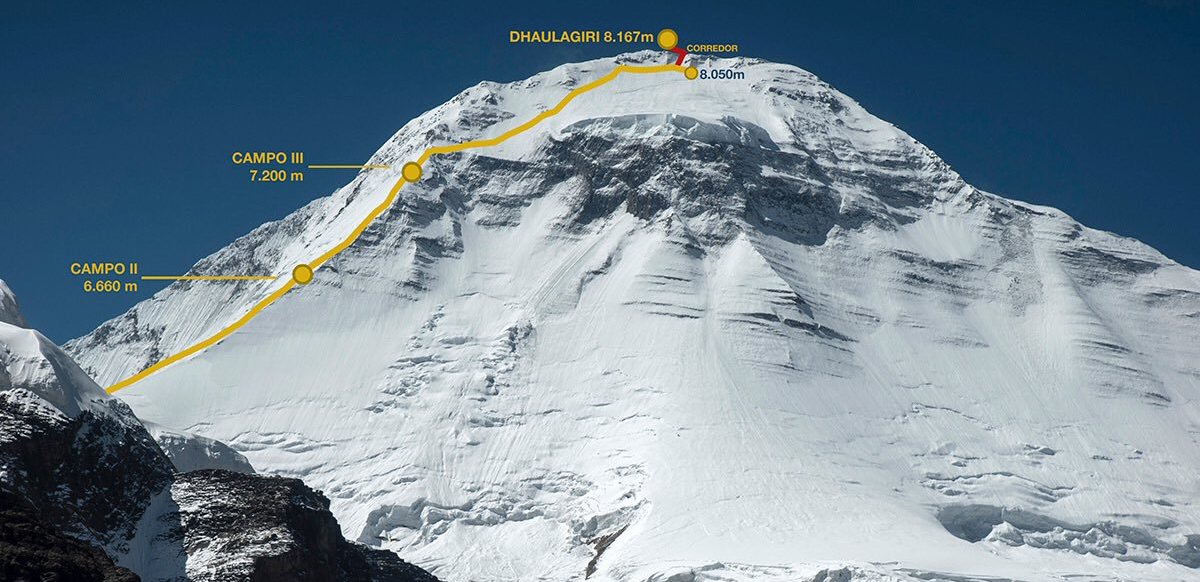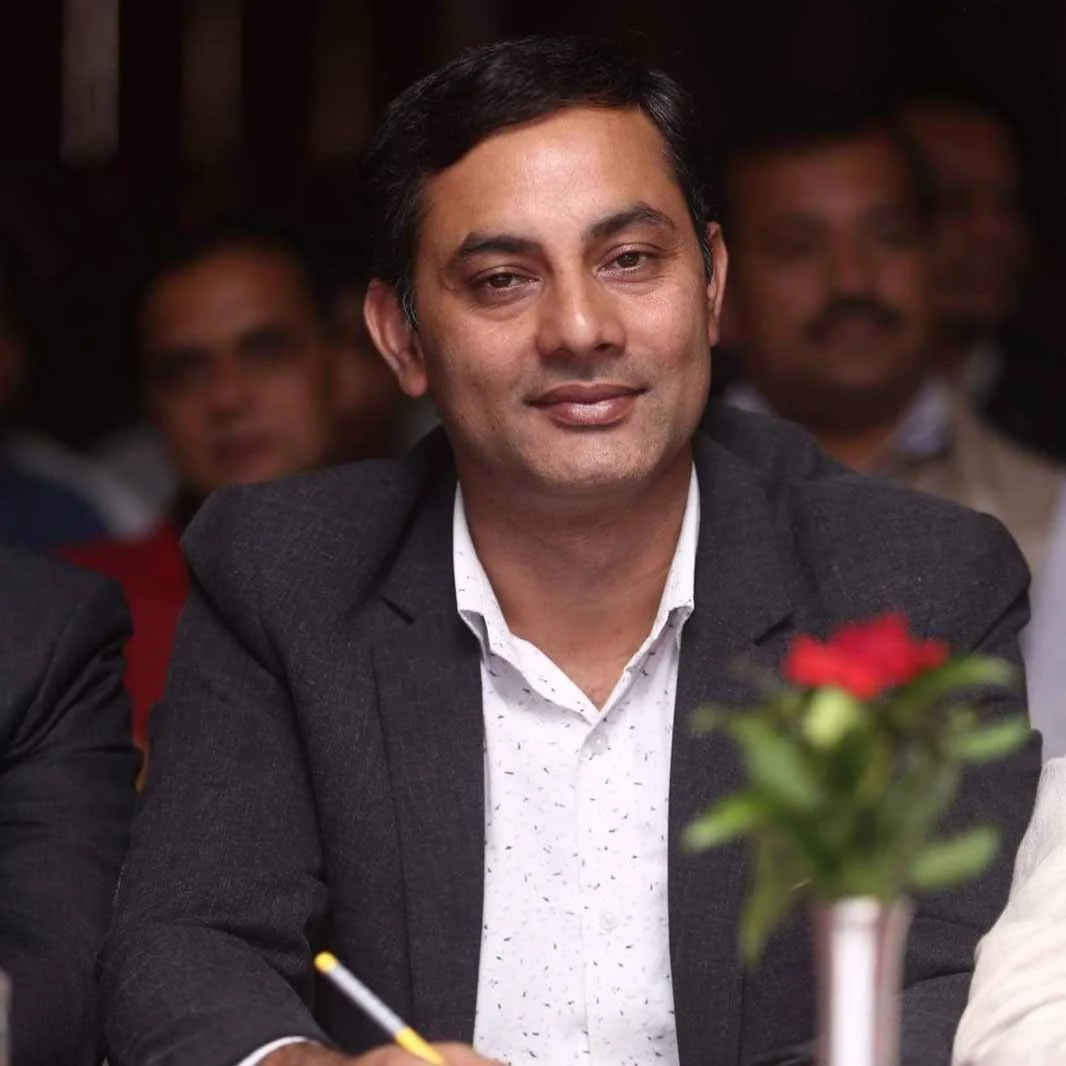
Mount Dhaulagiri (8,167m) gets its name from the Sanskrit term "Dhavala Giri," which means "White Mountain." Dhaulagiri is the world's seventh highest peak, with the most snow on its whole face, making it a truly white and gleaming mountain peak. This mountain is one of the Himalaya's real gems. While many people think of Cho Oyu as an easy 8000-meter summit, the "White Mountain" is known for being one of the most technically difficult 8000-meter peaks in the Himalayas. One of the attractive aspects of Dhaulagiri is the lack of large commercial expeditions; only experienced mountaineers appear to be interested in this daunting peak.
Nepalese mountaineer Babu Chiri Sherpa has climbed Mount Dhaulagiri multiple times. Babu's rapid ascent of Everest in 16 hours and 56 minutes and his 21-hour, 30-minute stay on the summit without supplementary oxygen were two of his most famous achievements. Many days of struggling on hostile terrain, perpendicular planes, icy sides, and planes swept by dangerous avalanches are required for the climb. The expedition's endeavor will be hampered further by the harsh weather, which includes ferocious breezes and sub-zero temperatures, as well as the mountain's dangerous illnesses.
For the first time, aerial photographs of the peak were obtained in 1949. From 1950 through 1959, French, Swiss, Argentineans, and Austrians attempted to summit the mountain; however, all attempts on the north side failed at roughly 8000 meters. On May 13 and 23, 1960, Swiss mountaineer E. Forrer and his team made the first successful ascent of the peak.
 Hotel
Hotel
 Welcome Dinner
Welcome Dinner
After arriving at Tribhuvan International Airport, proceed to your hotel. Our representative will take you to your destination. You can spend your free time socializing in a new location and atmosphere.
 Hotel
Hotel
 Breakfast
Breakfast
We start off on a sightseeing trip of Kathmandu Valley's most impressive and historic landmarks after breakfast in the hotel. Kathmandu Durbar Square, Bouddhanath Stupa, Pashupatinath Temple, and Swoyambhunath Stupa are all included in the tour. After the trip, check into your accommodation and spend the remainder of the day on your own.
 Hotel
Hotel
 Breakfast
Breakfast
We are going to prepare official documents today. If you require climbing equipment, you may get it in Kathmandu. Climbing equipment of the highest quality may be found in Kathmandu.
 Tented Camp
Tented Camp
 Breakfast/ Lunch/ Dinner
Breakfast/ Lunch/ Dinner
We take a long drive to Beni and Galeshor on a twisted hilly path. Arrive in Galeshor and spend the night in a tented camp.
 Tented Camp
Tented Camp
 Breakfast/ Lunch/ Dinner
Breakfast/ Lunch/ Dinner
After breakfast in Galeshor, we trek to Tatopani. Overnight in the tented camp
 Tented Camp
Tented Camp
 Breakfast/ Lunch/ Dinner
Breakfast/ Lunch/ Dinner
We head towards to Ghasa from Tatopani. Overnight stay in the tented camp.
 Tented Camp
Tented Camp
 Breakfast/ Lunch/ Dinner
Breakfast/ Lunch/ Dinner
Today we trek from Larjung to Marpha. Overnight in the camp
 Tented Camp
Tented Camp
 Breakfast/ Lunch/ Dinner
Breakfast/ Lunch/ Dinner
We trek from Marpha to Yak Kharka. Overnight in the camp
 Tented Camp
Tented Camp
 Breakfast/ Lunch/ Dinner
Breakfast/ Lunch/ Dinner
We trek from the camp at Yak Kharka to Dhaulagiri Base Camp, overnight in the camp
 Tented Camp
Tented Camp
 Breakfast/ Lunch/ Dinner
Breakfast/ Lunch/ Dinner
This is climbing period. We set up various camps, acclimatize and attempt climbing. Summit the most majestic peak of the Himalayas and then climb down.
 Tented Camp
Tented Camp
 Breakfast/ Lunch/ Dinner
Breakfast/ Lunch/ Dinner
Now we are ready to climb down and return.
 Tented Camp
Tented Camp
 Breakfast/ Lunch/ Dinner
Breakfast/ Lunch/ Dinner
We climb down now to Yak Kharka from the Base Camp.
 Tented Camp
Tented Camp
 Breakfast/ Lunch/ Dinner
Breakfast/ Lunch/ Dinner
We trek to Jomsom from Yak Kharka from where we can fly back to Pokhara.
 Hotel
Hotel
 Breakfast/ Lunch/ Dinner
Breakfast/ Lunch/ Dinner
We take an early flight to Pokhara from Jomsom, overnight in a hotel in Pokhara and celebrate the adventurous climbing trip of Dhaulagiri.
 Hotel
Hotel
 Breakfast
Breakfast
We drive back to Kathmandu from Pokhara. It is about 7 hours drive to Kathmandu. Upon arrival, you will be transferred to your hotel and free time for the rest of the day.
 Hotel
Hotel
 Breakfast
Breakfast
It is the day of rest or leisure for shopping, farewell dinner in the hotel and overnight in the hotel.
 Breakfast
Breakfast
We transfer you to the airport for your flight back to your home country or other destination.
Boots, Crampons, and Gaiters
1. Light hiking boots
2. 8000m climbing boots
3. Gaiters
4. Crampons (step-in bindings preferred)
Climbing Tools
1. Ice Axe: (standard; around 65–70 cm, depending on height)
Seat harness
2. Locking carabineers: 6 (Automatic locking type with large pear shape)
3. 2 folding- ski pole
Technical Clothing
1. Polypro or Capaline long underwear (4sets)
2. Pile jacket and pants (pants must have full separating side zips)
3. GoreTex shells (top and bottoms; bottoms must have full separating side zip)
4. Down jacket (medium & heavy weight)
Mitts & Gloves
1. Light synthetic gloves, 3 p.r. (Capaline or polypropaline)
2. Wool (or pile) mitts and Gor-Tex overmitts
Socks
1. Wool or pile socks (6pr light liners, 4pr heavy liners)
Headgear
1. Head lamp (spare bulbs and batteries)
2. Glacier: sun glasses
3. Wool or pile hat
Sleeping
1. Sleeping bag (expedition quality, rated to -15 & 40F)
2. Sleeping pads (2)
Camping
1. Backpack: Internal frame pack: 5,000 cu. in.
2. Pee bottle (one-liter largemouth)
3. Water bottles (2 one-liter largemouth)
4. Sunscreen (maximum block)
5. Lip sunscreen
Traveling
1. A large duffel bag for transporting all your gear at airports and on pack animals.
2. Toiletry bag
3. Travel clothes
4. Personal first aid kit
5. Small day pack: for trekking days (optional)


Discover more adventures like this one, offering the same incredible experiences and destinations. Find your next journey today!








































Mount Dhaulagiri (8,167m) gets its name from the Sanskrit term "Dhavala Giri," which means "White Mountain." Dhaulagiri is the world's seventh highest peak, with the most snow on its whole face, making it a truly white and gleaming mountain peak. This mountain is one of the Himalaya's real gems. While many people think of Cho Oyu as an easy 8000-meter summit, the "White Mountain" is known for being one of the most technically difficult 8000-meter peaks in the Himalayas. One of the attractive aspects of Dhaulagiri is the lack of large commercial expeditions; only experienced mountaineers appear to be interested in this daunting peak.
Nepalese mountaineer Babu Chiri Sherpa has climbed Mount Dhaulagiri multiple times. Babu's rapid ascent of Everest in 16 hours and 56 minutes and his 21-hour, 30-minute stay on the summit without supplementary oxygen were two of his most famous achievements. Many days of struggling on hostile terrain, perpendicular planes, icy sides, and planes swept by dangerous avalanches are required for the climb. The expedition's endeavor will be hampered further by the harsh weather, which includes ferocious breezes and sub-zero temperatures, as well as the mountain's dangerous illnesses.
For the first time, aerial photographs of the peak were obtained in 1949. From 1950 through 1959, French, Swiss, Argentineans, and Austrians attempted to summit the mountain; however, all attempts on the north side failed at roughly 8000 meters. On May 13 and 23, 1960, Swiss mountaineer E. Forrer and his team made the first successful ascent of the peak.
After arriving at Tribhuvan International Airport, proceed to your hotel. Our representative will take you to your destination. You can spend your free time socializing in a new location and atmosphere.
We start off on a sightseeing trip of Kathmandu Valley's most impressive and historic landmarks after breakfast in the hotel. Kathmandu Durbar Square, Bouddhanath Stupa, Pashupatinath Temple, and Swoyambhunath Stupa are all included in the tour. After the trip, check into your accommodation and spend the remainder of the day on your own.
We are going to prepare official documents today. If you require climbing equipment, you may get it in Kathmandu. Climbing equipment of the highest quality may be found in Kathmandu.
We take a long drive to Beni and Galeshor on a twisted hilly path. Arrive in Galeshor and spend the night in a tented camp.
After breakfast in Galeshor, we trek to Tatopani. Overnight in the tented camp
We head towards to Ghasa from Tatopani. Overnight stay in the tented camp.
Today we trek from Larjung to Marpha. Overnight in the camp
We trek from Marpha to Yak Kharka. Overnight in the camp
We trek from the camp at Yak Kharka to Dhaulagiri Base Camp, overnight in the camp
This is climbing period. We set up various camps, acclimatize and attempt climbing. Summit the most majestic peak of the Himalayas and then climb down.
Now we are ready to climb down and return.
We climb down now to Yak Kharka from the Base Camp.
We trek to Jomsom from Yak Kharka from where we can fly back to Pokhara.
We take an early flight to Pokhara from Jomsom, overnight in a hotel in Pokhara and celebrate the adventurous climbing trip of Dhaulagiri.
We drive back to Kathmandu from Pokhara. It is about 7 hours drive to Kathmandu. Upon arrival, you will be transferred to your hotel and free time for the rest of the day.
It is the day of rest or leisure for shopping, farewell dinner in the hotel and overnight in the hotel.
We transfer you to the airport for your flight back to your home country or other destination.
Boots, Crampons, and Gaiters
1. Light hiking boots
2. 8000m climbing boots
3. Gaiters
4. Crampons (step-in bindings preferred)
Climbing Tools
1. Ice Axe: (standard; around 65–70 cm, depending on height)
Seat harness
2. Locking carabineers: 6 (Automatic locking type with large pear shape)
3. 2 folding- ski pole
Technical Clothing
1. Polypro or Capaline long underwear (4sets)
2. Pile jacket and pants (pants must have full separating side zips)
3. GoreTex shells (top and bottoms; bottoms must have full separating side zip)
4. Down jacket (medium & heavy weight)
Mitts & Gloves
1. Light synthetic gloves, 3 p.r. (Capaline or polypropaline)
2. Wool (or pile) mitts and Gor-Tex overmitts
Socks
1. Wool or pile socks (6pr light liners, 4pr heavy liners)
Headgear
1. Head lamp (spare bulbs and batteries)
2. Glacier: sun glasses
3. Wool or pile hat
Sleeping
1. Sleeping bag (expedition quality, rated to -15 & 40F)
2. Sleeping pads (2)
Camping
1. Backpack: Internal frame pack: 5,000 cu. in.
2. Pee bottle (one-liter largemouth)
3. Water bottles (2 one-liter largemouth)
4. Sunscreen (maximum block)
5. Lip sunscreen
Traveling
1. A large duffel bag for transporting all your gear at airports and on pack animals.
2. Toiletry bag
3. Travel clothes
4. Personal first aid kit
5. Small day pack: for trekking days (optional)
© 2011 - 2022 All rights reserved. Mountain Delights Treks and Expedition Pvt. Ltd. Developed By : Xenatech Nepal